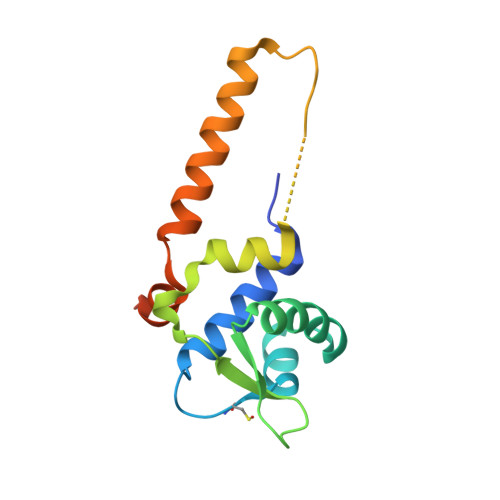Staphylococcus aureus CymR Is a New Thiol-based Oxidation-sensing Regulator of Stress Resistance and Oxidative Response.
Ji, Q., Zhang, L., Sun, F., Deng, X., Liang, H., Bae, T., He, C.(2012) J Biol Chem 287: 21102-21109
- PubMed: 22553203
- DOI: https://doi.org/10.1074/jbc.M112.359737
- Primary Citation of Related Structures:
3T8R, 3T8T - PubMed Abstract:
As a human pathogen, Staphylococcus aureus must cope with oxidative stress generated by the human immune system. Here, we report that CymR utilizes its sole Cys-25 to sense oxidative stress. Oxidation followed by thiolation of this cysteine residue leads to dissociation of CymR from its cognate promoter DNA. In contrast, the DNA binding of the CymRC25S mutant was insensitive to oxidation and thiolation, suggesting that CymR senses oxidative stress through oxidation of its sole cysteine to form a mixed disulfide with low molecular weight thiols. The determined crystal structures of the reduced and oxidized forms of CymR revealed that Cys-25 is oxidized to Cys-25-SOH in the presence of H(2)O(2). Deletion of cymR reduced the resistance of S. aureus to oxidative stresses, and the resistance was restored by expressing a C25S mutant copy of cymR. In a C25S substitution mutant, the expression of two genes, tcyP and mccB, was constitutively repressed and did not respond to hydrogen peroxide stress, whereas the expression of the genes were highly induced under oxidative stress in a wild-type strain, indicating the critical role of Cys-25 in redox signaling in vivo. Thus, CymR is another master regulator that senses oxidative stress and connects stress responses to virulence regulation in S. aureus.
Organizational Affiliation:
Department of Chemistry, The University of Chicago, Chicago, Illinois 60637, USA.















